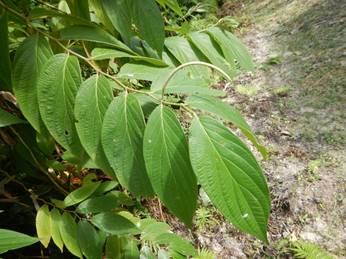Piper aduncum
What to look for
A shrub or small tree that can grow to eight metres. The plant features erect branches with aromatic leaves that droop. Mature plants flower and fruit throughout the year: flowers are cream-coloured and develop opposite most leaves.
What you can do
- Do not move plants, plant material or soil out of the Torres Strait Protected Zone to the Torres Strait Permanent Biosecurity Monitoring Zone, or from either zone to mainland Australia without a permit and an inspection by a departmental biosecurity officer.
- Report any signs of suspect exotic plants to the department by phone on +61 7 4241 7800 or email NAQS.

Profile
Spiked pepper is a small tree with brittle timber and aromatic foliage. It is closely related to the culinary spice pepper. Its stems are swollen at the nodes, giving a cane-like appearance, and it often has stilt-roots near the base. Sometimes cultivated as an ornamental, spiked pepper has escaped from cultivation in humid tropical regions and is increasingly becoming a serious weed of pastures, fallow agricultural plots and recently logged forests, where its growth is so dense that it inhibits regeneration of native and beneficial timber species. It produces vast numbers of tiny seeds that are dispersed by birds, fruit bats and as contaminants on vehicles and machinery.

Leaves have a drooping appearance
Identification
Spiked pepper plants grow up to eight metres tall and may be single or multi-stemmed. Branches are erect but the alternately arranged leaves hang downwards to give a drooping appearance. The leaves are 12–22 cm long with a pointed tip, paler on the undersides and slightly rough to touch. Slender cream-coloured flower spikes develop opposite most leaves, maturing up to 20 cm long. Individual flowers are tiny and closely packed. Mature plants flower and fruit throughout the year. Birds and mammals eat the fruit and disperse the seeds.
Distribution
Spiked pepper originated in Central America but has now established wild populations in South East Asia, Indonesia, Malaysia, Papua New Guinea and the Pacific Islands of Vanuatu, Fiji and the Solomon Islands. The only known occurrence in Australia is on Christmas Island.

Dense infestations invade pastures and inhibit growth of native species
Threat
Spiked pepper could enter Australia as a contaminant of footwear, vehicles and raw timber imported from infested areas. It poses a serious weed threat to humid tropical regions of northern Australia, particularly in the vicinity of the Wet Tropics World Heritage Area. It is unpalatable to livestock, invades degraded pastures, forms impenetrable stands and replaces more desirable species in the understory of disturbed forests.
Keep a Top Watch!
Be vigilant for any new or unfamiliar plants in your region. Early detection of weeds before they are widely established minimises the costs of eradication. If you think you have found spiked pepper contact your local department office immediately.

Multi-stemmed trees impede access and shade the underlying ground

Fruiting spikes contain masses of tiny seeds
Report any unusual trees that you don’t recognise.
